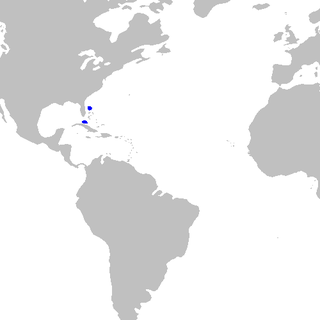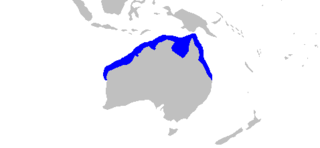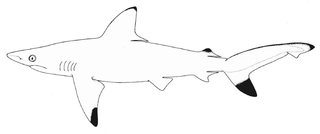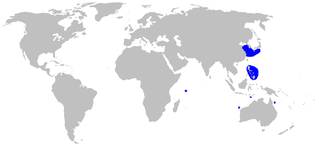The Centrophoridae are a family of squaliform sharks. The family contains just two genera and about 15 species. They are sometimes called gulper sharks, but this is also the name of a specific species in the family, Centrophorus granulosus. These are generally deepwater fish. While some, such as the gulper shark C. granulosus, are found worldwide and fished commercially, others are uncommon and little-known. Their usual prey is other fish; some are known to feed on squid, octopus, and shrimp. Some species live on the bottom (benthic), while others are pelagic. They are ovoviviparous, with the female retaining the egg-cases in her body until they hatch.

The Bahamas sawshark, Pristiophorus schroederi, is a sawshark of the family Pristiophoridae, found in the western Central Atlantic Ocean from the Bahamas and Cuba at depths of between 400 and 1,000 m. These sharks are at least 80 cm long.
Centrophorus is a genus of squaliform sharks. These deep-water sharks, found in temperate and tropical oceans throughout the world, are characterized by grey or brown bodies, large green eyes, and spines on both dorsal fins. These spines give them their name, from Greek κεντρον, kentron meaning "thorn" and φέρειν, pherein meaning "to bear".

The dumb gulper shark is a rare and endangered deepwater dogfish, known from only along the east coast of Australia and isolated spots north and west of New Zealand. It is also known as the dumb shark, Harrison's deep-sea dogfish, or Harrison's dogfish.

The lowfin gulper shark is a large deepwater dogfish in the family Centrophoridae.

The smallfin gulper shark is a medium-sized deepwater dogfish in the family Centrophoridae.

The leafscale gulper shark is a dogfish of the family Centrophoridae. C. squamosus is reported to have a lifespan of approximately 70 years, based on otolith ring counts. It was the first described species in the genus Centrophorus, which now contains 13 species.

The mosaic gulper shark is a small rare deepwater dogfish, found in the Pacific Ocean around Honshū, Japan and the Hawaiian Islands at depths between 260 and 728 m. It is one of 13 described species in the genus Centrophorus.

The little gulper shark is a small, deepwater dogfish of the family Centrophoridae.

The bigeye sand tiger is an extremely rare species of mackerel shark in the family Odontaspididae, with a possible worldwide distribution. A large, bulky species reaching at least 3.6 m (12 ft) in length, the bigeye sand tiger has a long bulbous snout, large orange eyes without nictitating membranes, and a capacious mouth with the narrow teeth prominently exposed. It can be distinguished from the similar smalltooth sand tiger by its teeth, which have only one lateral cusplet on each side, and by its uniformly dark brown color.

The creek whaler is a common species of requiem shark, and part of the family Carcharhinidae, endemic to northern Australia. It frequents shallow waters close to shore, including estuaries. This small, stocky shark usually grows to 1.0–1.3 m (3.3–4.3 ft) long and is brownish in color without conspicuous fin markings. It can be identified by its long snout, large, triangular pectoral fins, and large, anteriorly positioned first dorsal fin.

The whitecheek shark or widemouth blackspot shark is a requiem shark of the family Carcharhinidae, found in the Indo-West Pacific Ocean between latitudes 34°N and 25°S. It can reach a length of 1 m. It feeds mainly on fish, cephalopods, and crustaceans. It is a viviparous species, with the female giving birth to up to four live young.

The Pondicherry shark is an extremely rare species of requiem shark, in the family Carcharhinidae. A small and stocky gray shark, it grows not much longer than 1 m (3.3 ft) and has a fairly long, pointed snout. This species can be identified by the shape of its upper teeth, which are strongly serrated near the base and smooth-edged near the tip, and by its first dorsal fin, which is large with a long free rear tip. Furthermore, this shark has prominent black tips on its pectoral fins, second dorsal fin, and caudal fin lower lobe.

The blackspot shark is a small species of requiem shark in the family Carcharhinidae found in the tropical Indo-West Pacific Ocean between latitudes 24°N and 30°S, from the surface to a depth around 40 m (130 ft). Its length is a little under one meter (yard) and it is not considered to be dangerous to humans. It feeds mainly on fish, crustaceans, and squid. This shark is also caught in small-scale fisheries for human consumption.

The longnose pygmy shark is a rare species of squaliform shark in the family Dalatiidae and the only member its genus. It is known only from a handful of specimens collected from the cold oceanic waters of the Southern Hemisphere, between the surface and a depth of 502 m (1,647 ft). Reaching 37 cm (15 in) in length, this diminutive shark is characterized by a slender, dark brown body with a very long, bulbous snout. In addition, it has two spineless dorsal fins of nearly equal size, with the origin of the first lying over the pectoral fin bases. The longnose pygmy shark does not appear substantially threatened by fisheries, and has been assessed as Least Concern by the International Union for Conservation of Nature (IUCN).

The longnose sawtail catshark is a little-known species of catshark, part of the family Scyliorhinidae, found off the northwestern Pacific islands of Amami Ōshima, Ogasawara, and Izu at depths of 350–550 m (1,150–1,800 ft). Reaching a length of 80 cm (31 in), it is characterized by a long flattened snout, a long space between the pelvic and anal fins, and a crest of enlarged dermal denticles along the dorsal caudal fin edge. Adults are plain dark gray above, while juveniles have a few faint dark saddles on the back and tail.

The longhead catshark or smoothbelly catshark is a species of catshark, family Scyliorhinidae, with a patchy distribution in the Indo-Pacific from Mozambique to southern Japan to northern Australia. It is found in water between 500 and 1,140 m deep. This species grows to 59 cm (23 in) long and is characterized by its extremely long and narrow snout, short abdomen, and long anal and caudal fins. In addition, a large area of the anterior ventral portion of its body lacks dermal denticles. The longhead catshark is oviparous and the only known cartilaginous fish that is normally hermaphroditic, with the majority of individuals having both the functional reproductive organs of one sex and the undeveloped reproductive organs of the opposite sex.
The Triton epaulette shark is a species of bamboo shark in the genus Hemiscyllium, that is composed of nine morphologically similar, yet distinct sharks that are geographically restricted to New Guinea and northern Australia. Hemiscylliidae are small nocturnal sharks aptly named "walking sharks" who exhibit a "crawling" movement while foraging on the ocean floor for fish and benthic invertebrates.
The Cook's swellshark is a little-known species of catshark, belonging to the family Scyliorhinidae. This shark is found in the Arafura Sea at a depth of 223–300 m (732–984 ft). It is a stocky-bodied shark with a short, broad head and a large mouth, and can be identified by the eight dark, pale-edged saddles along its grayish brown body and tail. The maximum known length of this species is 30 cm (12 in). Like other swellsharks, it can inflate itself with water or air when threatened.
The flagtail swellshark is a little-known species of catshark, belonging to the family Scyliorhinidae, found at a depth of 480–700 m (1,570–2,300 ft) off northeastern Queensland, and possibly also nearby islands. This stout-bodied shark has a short, broad, and flattened head with a capacious mouth. Adults have a variegated brown coloration with 9–10 darker dorsal saddles and "V"-shaped blotch at the tip of the upper caudal fin lobe. Juveniles are yellow with narrow brown bars instead of saddles, and a distinctive marking between the spiracles shaped like two loops connected by a line. Like other swellsharks, this species can inflate its body when threatened.

















